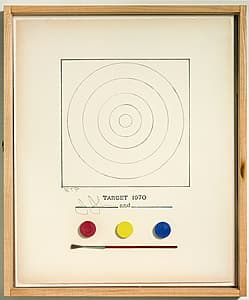

Jasper Johns
Learn moreTarget 1970
© Jasper Johns. VAGA/Copyright Agency Purchased 1973
More detail | PermalinkAt a time when the emotionally-charged paintings of Abstract Expressionism dominated the American avant-garde, Jasper Johns began to reframe everyday objects and symbols as valid subjects for fine art. Drawing influence from the traditions of Dada—particularly the absurdist humour and use of ready-made subject matter—his work was identified with the Neo-Dada movement and became a foundation for American Pop art.
Targets—specifically targets composed of five concentric circles in alternating rings of blue and yellow, on a red background—are another motif repeated in Johns’ paintings and prints. Target 1971 seems to present a colouring-in activity with a target template, paints and paintbrush. In this witty work the punchline is hard to place. To accept it as a genuine invitation to physically add in the colours would surely be to miss the point and destroy the pristine work of art. Maybe we are meant to let our minds do the work and see colour in the blank spaces? But perhaps the joke is on artworld consumers who, paralysed by fears of failing to ‘get’ the meaning of this contemporary art object or concerns about ruining the artwork (or worse, its resale value), take the idea of ‘art’ too seriously and rebuff a genuine opportunity to collaborate.[i] The relationship between artist, object and viewer was an ongoing preoccupation for Johns and by literally compelling the audience to participate—whether in thought, action or both—he highlights the role that the viewer necessarily plays in constructing a work of art’s meaning.
Alice Desmond
[i] This template and colouring pads were also issued with the catalogue for the Museum of Modern Art’s exhibition Technics and creativity: Selections from Gemini G.E.L. in 1971, which was published in an edition of 22,500. The accompanying catalogue Technics and creativity: Gemini G.E.L., Museum of Modern Art, New York, 1971 literally ‘invites you to collaborate with Jasper Johns in creating your own version of his Target’.

